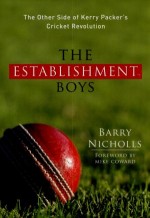The Establishment Boys
Martin Chandler |Published: 2015
Pages: 252
Author: Nicholls, Barry
Publisher: New Holland
Rating: 3.5 stars

Professional cricket changed forever in the 1970s. The catalyst was Australian media tycoon Kerry Packer and his decision, after the Australian Broadcasting Corporation refused to sell him the rights to broadcast Test cricket, to buy up the world’s best players and start his own rival attraction; World Series Cricket (WSC).
There has always been a good deal of interest in WSC, and no shortage of the those willing to discuss it. Not counting Jeff Thomson, who at different times had a foot in each camp, no fewer than 33 of the men who played for Packer’s rival attraction have written autobiographies or been the subject of books written by others. There were also two books published at the time chronicling the story as a whole, and there have been a couple more since.
Against that backdrop it is easy to forget that during the WSC hiatus Australia played 24 official Test matches. With the exception of Thomson no Packer player was selected for any of those matches. There were 31 men capped during this period, all but eight of them debutants. Of the 31 only the stories of Bob Simpson, called back to the colours a decade after retirement to captain the side, future skippers Alan Border and Kim Hughes and bowlers Bruce Yardley and Rod Hogg have ever appeared in print.
There is however an irony as far as the cricket was concerned. All who saw them say that the WSC matches contained some dramatic cricket of the highest quality. Despite that even today there is no trace of the matches in the official statistics of the game. On the other hand the Tests played by an Australian side missing 28 of their leading players are still very much part of the record books. The first series, in Australia against India, was keenly contested and won 3-2 by the Australians, although a return series two years later was less interesting. England’s losses to WSC were not great, and an almost full strength England won the 78-79 Ashes 5-1. West Indies, complete with WSC players were far too strong for Simpson’s men although when WSC’s West Indians took their leave part way through the 1977/78 series the remaining matches were rather more competitive. A year later the Australians, by then led by Hughes, did take a Test from a full strength Pakistan side, however in the 1979 World Cup only Canada were beaten.
By choosing to tell the story of the Australians who remained loyal to the board Barry Nicholls has chosen a subject no writer has sought to concentrate on before. With five Test series to look at, of which only the 1978/79 Ashes series has been written about at any length, as well as the lives and careers of so many lesser lights there was never going to be a shortage of material. Add to that the fact that, having been there as a teenager, Nicholls had his own vivid memories to draw on and my expectations of The Establishment Boys were pretty high.
The book hit the shops last year so there has been something of a delay in reviewing it. Part of the reason for that was my being rather put off by a review I read a little while ago. One of the game’s foremost writers spent most of a two page review highlighting a number typos and a couple of continuity errors. He isn’t wrong, and a better proof reader would certainly have ironed out all the problems that are identified, but rather more time could and should have been spent on the book’s real strength, the simple fact that it is an interesting subject.
The early chapters, which give the background to the momentous split, have of course been covered before, but never to my knowledge from the perspective of those who represented Australia during those 24 Tests. There follows an account of the matches themselves. No writer can make ordinary cricket memorable, and whilst there were some notable individual performances and a handful of exciting games the reality is that most of the matches involving The Establishment Boys were fairly mundane. It was however Nicholls’ duty to the game’s future historians to give an account of the play, and it is difficult to see how he could have done that any better with the material at his disposal.
The most interesting aspect of the book, probably inevitably, are the closing chapters that contain a post mortem and the obligatory accounts of what The Establishment Boys went on to achieve in the rest of their careers and, more importantly given that only seven of them played any more international cricket, what they did with their lives after leaving the game. The most interesting characters, to this reviewer, are probably Ian ‘Mad Dog’ Callen and Rick Darling, but the tales of those who scale the game’s heights only fleetingly are always of particular interest, and there are plenty of them here.
The selection of photographs that illustrate The Establishment Boys is excellent, and the scorecards of the 24 Tests are faithfully reproduced. It would have been useful to have a summary of the career statistics of the players, but along with the proof reading issues those are minor complaints about a book that is a thoroughly worthwhile way of whiling away a few hours of its reader’s time.






Leave a comment